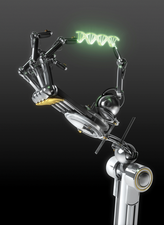Controlling a four-axis robot arm
Gentle Touch

© Lead Image © marc heriche, Fotolia.com
Learn the basics of robotics with a Raspberry Pi and a PiXtend controller.
Robotics might seem like a daunting subject to tackle, but a Raspberry Pi, a PiXtend module, Codesys control software, and a bit of Structured Text (ST) programming are all you need to get started in this compelling discipline. In this article, I describe how to set up and program a robot arm.
For this project, I opted for the four-axis robot arm by SainSmart [1]; it has a good price-to-performance ratio and a large working range. Simple hobby servos let the robot arm equipped with a simple gripper [2] move objects. The Thingiverse website provides the 3D printer files for printing the gripper [3]; alternatively, you can purchase the gripper on Amazon [4]. The gripper also is driven by a servo and requires a PWM signal for control. For more information on servos, see the box "How Servos Work."
The best way to keep track of the motors is to label each one (Table 1). Figure 2 shows the robot with the gripper, and the wiring diagram in Figure 3 shows how to connect the individual motors. Please note that hobby servos can handle a maximum of 6V.
[...]
Buy this article as PDF
(incl. VAT)
Buy Linux Magazine
Subscribe to our Linux Newsletters
Find Linux and Open Source Jobs
Subscribe to our ADMIN Newsletters
Support Our Work
Linux Magazine content is made possible with support from readers like you. Please consider contributing when you’ve found an article to be beneficial.

News
-
Valve Announces Pending Release of Steam Machine
Shout it to the heavens: Steam Machine, powered by Linux, is set to arrive in 2026.
-
Happy Birthday, ADMIN Magazine!
ADMIN is celebrating its 15th anniversary with issue #90.
-
Another Linux Malware Discovered
Russian hackers use Hyper-V to hide malware within Linux virtual machines.
-
TUXEDO Computers Announces a New InfinityBook
TUXEDO Computers is at it again with a new InfinityBook that will meet your professional and gaming needs.
-
SUSE Dives into the Agentic AI Pool
SUSE becomes the first open source company to adopt agentic AI with SUSE Enterprise Linux 16.
-
Linux Now Runs Most Windows Games
The latest data shows that nearly 90 percent of Windows games can be played on Linux.
-
Fedora 43 Has Finally Landed
The Fedora Linux developers have announced their latest release, Fedora 43.
-
KDE Unleashes Plasma 6.5
The Plasma 6.5 desktop environment is now available with new features, improvements, and the usual bug fixes.
-
Xubuntu Site Possibly Hacked
It appears that the Xubuntu site was hacked and briefly served up a malicious ZIP file from its download page.
-
LMDE 7 Now Available
Linux Mint Debian Edition, version 7, has been officially released and is based on upstream Debian.

